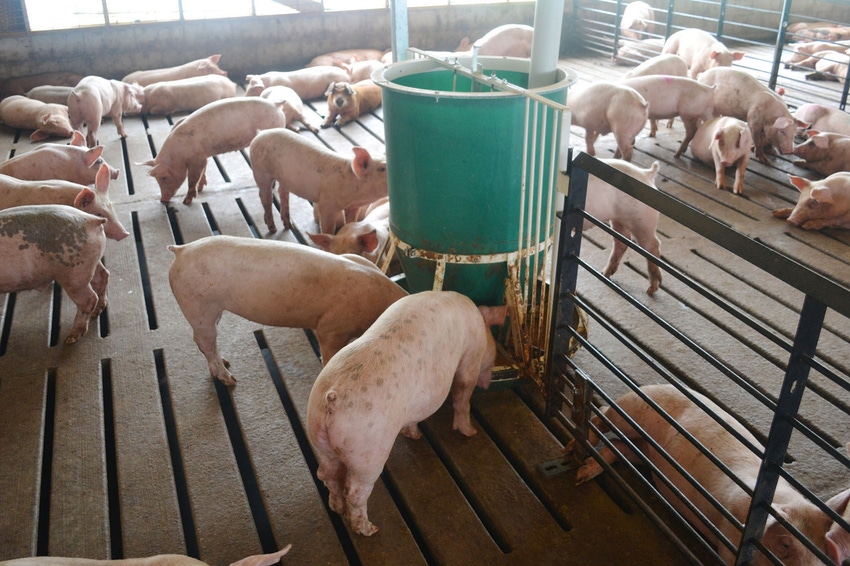As traditional feedstuffs become increasingly expensive, cDDGS may be used as an alternative in swine diets replacing a portion of corn, soybean meal.
December 15, 2022

As the biofuel production industry expands in response to federal biofuel polices to reduce greenhouse gas emissions and fossil fuel usage, agro-industrial byproducts such as corn distillers dried grains with solubles and soybean meal will be more available for animal feeding. As traditional feedstuffs such as corn become increasingly expensive, cDDGS may be used primarily as an alternative ingredient in swine diets replacing a portion of the corn and SBM to reduce feed cost.
It is well known that inclusion of cDDGS in swine diets above 20% can negatively impact growth performance of pigs. The high leucine content of corn and cDDGS can cause imbalanced branched chain amino acids to lysine ratios in the diets thus leading to the poor growth performance of pigs.
Recent studies have reported that additions of synthetic amino acids including valine, isoleucine or tryptophan to adjust amino acids ratios in cDDGS-containing diets could ameliorate poor growth performance of the pigs. However, applying a single ratio of BCAA:Lys across diet phases for grow-finish pigs may cause amino acid imbalances that reduce performance and increase nitrogen excretion in manure. Moreover, the expense of synthetic amino acids to balance the BCAA:Lys ratio in cDDGS diets increases the feed cost.
Therefore, grow-finish pigs were fed diets with high inclusions of cDDGS (30% during the growing period and 20% during the finishing period) to investigate the impact of different BCAA:Lys strategies. This study was conducted at the South Dakota State University commercial wean-to-finish research facility near Flandreau, South Dakota. A total of 1,140 grower pigs (DNA 610 x PIC) with an initial body weight of 63 pounds were housed in 45 pens during the 11-week trial.
Pens of pigs were fed one of five diets over four phases based on BW (Phase 1: 55-110 lbs, Phase 2: 110-165 lbs, Phase 3: 165-220 lbs and Phase 4: 220-300 lbs):
Positive control: a corn-SBM based diet with SID BCAA:Lys according to PIC nutrient recommendations (2020)
Negative control: a cDDGS diet with SID BCAA:Lys according to PIC nutrient recommendations (2020)
Grow: NC diet with SBM added to adjust the dietary SID valine:lysine ratios to 73%, the SID isoleucine:lysine ratios to 60%, and the SID leucine:lysine ratios to 144% for the entire feeding period
Finish: NC diet with SBM added to adjust the dietary SID valine:lysine ratios to 78%, the SID isoleucine:lysine ratios to 70%, and the SID leucine:lysine ratios of 160-170% for the entire feeding period
Grow-Finish: NC diet with dietary SID BCAA:Lys ratios adjusted by SBM as above for the grower pigs (Phases 1 and 2) and the finisher pigs (Phases 3 and 4), respectively
Pigs fed the cDDGS diets with the higher BCAA:Lys ratios (i.e. finish) tended to be heavier at the end of the experimental period compared to pigs fed the other cDDGS diets, but similar in final body weight to pigs fed a corn-SBM based diet.
The cDDGS diets with SID BCAA:Lys ratios adjusted by SBM inclusion had lower feed cost per ton for Phases 1 to 4 by 4.7%, 4.6-5.2%, 3.0-3.3% and 2.2-3.2% compared to the corn-SBM diet. Furthermore, economic calculations to the constant carcass weight of 280 pound indicated that feeding the finish diet had greater income over feed cost and income over feed and facility cost than feeding the PC diet and other cDDGS diets.
In conclusion, feeding grower pigs diets containing 30% cDDGS and finisher pigs diets containing 20% cDDGS with SID branched chain amino acids to lysine ratios adjusted to 78% valine:lysine, 70% isoleucine:lysine, and 160-170% leucine:lysine throughout by SBM inclusion would benefit swine producers by supporting growth performance compared to standard corn-SBM diets and providing economic benefits.
Source: Jinsu Hong, Ryan Samuel, Paul Cline and David Clizer, who are solely responsible for the information provided, and wholly owns the information. Informa Business Media and all its subsidiaries are not responsible for any of the content contained in this information asset.
You May Also Like



